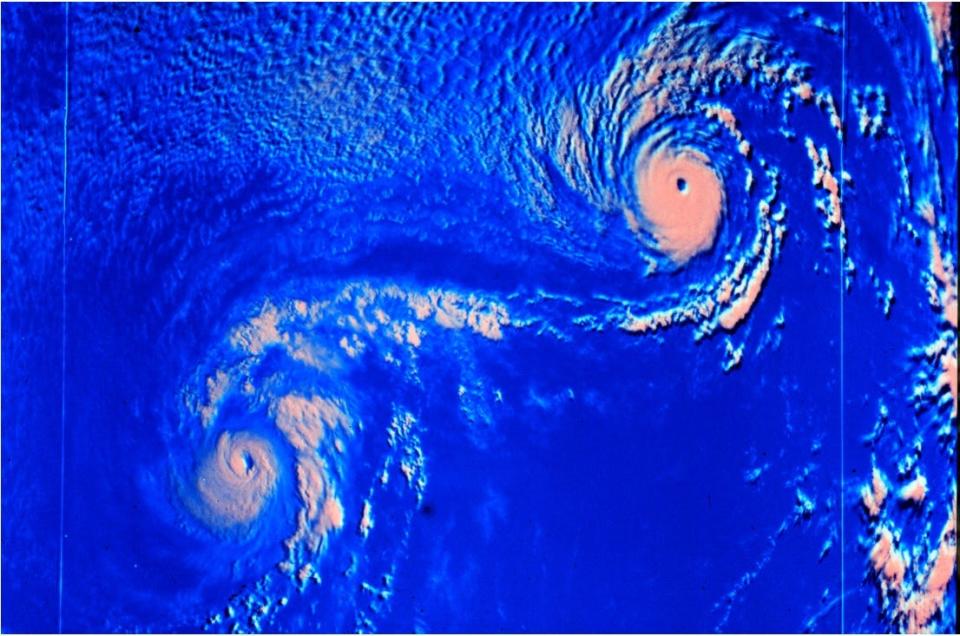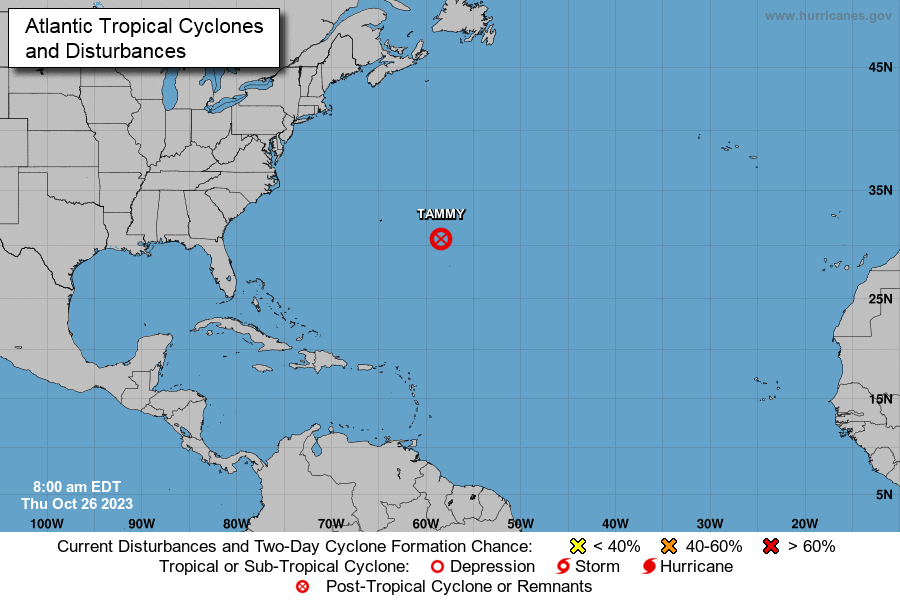Tropical storms Philippe, Rina are colliding, creating the Fujiwhara Effect. What's that?
A pair of tropical storms continued to spin in the open Atlantic Ocean Friday, neither an immediate direct threat to land but close enough to each other to cause a rare interaction known as the Fujiwhara Effect.
The two storms – Tropical Storms Philippe and Rina – were roughly 575 miles apart from each other as of Friday morning, and the National Hurricane Center said "some degree of interaction is likely" between them due to their proximity to each other.
"The next several days are likely to see a classic example of the Fujiwhara Effect playing out in the Atlantic," wrote meteorologist Jeff Masters on his Yale Climate Connections blog.
And according to meteorologist Matt Lanza's blog The Eyewall, "the two systems would track close enough to one another to impact each other’s track." In this case, Philippe would likely slow, stall, or get pushed to the south since it’s ahead of Rina, and Rina would basically slingshot over the top of Philippe either west or northwest and out to sea, he said.
Miami-based meteorologist John Morales, writing on X, said the two storms are "expected to pivot around each other, with one becoming more dominant. Now, neither is expected to hit the Caribbean."

What is the Fujiwhara Effect?
Basically, the Fujiwhara Effect describes the rotation of two storms around each other. It's most common with tropical cyclones such as typhoons or hurricanes, but it also occurs in other cases.
When two hurricanes spinning in the same direction pass close enough to each other, they begin an intense dance around their common center, the National Weather Service said.
The effect is thought to occur when storms get about 900 miles apart.
Square dancing and ice skaters
Storms involved in the Fujiwhara Effect rotate around one another as if they had locked arms and were square dancing. Rather than each storm spinning about the other, they are actually moving about a central point between them, as if both were tied to the same post and each swung around it separately from the other.
A good way to picture this is to think of two ice skaters who skate quickly toward each other, nearly on a collision course, grab hands as they are about to pass and spin vigorously around in one big circle with their joined hands at the center.
The effect is named after Dr. Sakuhei Fujiwhara who was the chief of the Central Meteorological Bureau in Tokyo shortly after the first World War. In 1921, he wrote a paper describing the motions of "vortices" in water. Water vortices, such as whirlpools, are little water whirls that spin around.
Noaa
Embedded content: https://www.nhc.noaa.gov/xgtwo/two_atl_0d0.png?052051
What is the forecast for Tropical Storm Philippe?
The National Hurricane Center, in its 11 a.m. ET forecast discussion for Tropical Storm Philippe, said that the storm "has only moved roughly 40 miles over the past 24 hours, and it has been generally drifting to the southwest during that time.
"The slow motion over the past day or so is due to its interaction with Tropical Storm Rina several hundred miles to its east. Since these tropical cyclones are expected to continue to interact through the weekend, Philippe is forecast to crawl southwestward during the next 2 or 3 days."
As for intensity, forecasters are predicting Philippe could strengthen over the weekend and into next week before it curves north away from the Leeward Islands. Current forecasts have inched up, and Philippe could be near hurricane strength with 70-mph winds in 72 hours.
As of Friday morning, the center of Philippe was located 510 miles east of the northern Leeward islands. It had winds of 45 mph and was moving at 2 mph.
The hurricane center said that swells generated by Philippe will affect portions of the Atlantic coasts of the northern Leeward Islands, the Virgin Islands, and Puerto Rico through the weekend. "These swells are likely to cause life-threatening surf and rip current conditions," the center warned.
What is the forecast for Tropical Storm Rina?
As for Rina, the tropical storm is moving north-northwestward, with a forward speed near 6 mph, as of Friday morning. "Most of the track guidance shows Rina moving generally northwestward through the weekend between nearby Tropical Storm Philippe and a subtropical ridge over the central Atlantic," the hurricane center said Friday.
"Confidence in the track forecast (for Rina) is lower than normal based on the model spread and uncertainty regarding the potential interaction with Tropical Storm Philippe during the next several days," the hurricane center said late Thursday.
Rina is not expected to strengthen over the next day or so and is forecast to weaken through early next week.
No warnings were issued for any land areas due to Tropical Storm Rina.
Track Tropical Storm Philippe

Special note on the NHC cone: The forecast track shows the most likely path of the center of the storm. It does not illustrate the full width of the storm or its impacts, and the center of the storm is likely to travel outside the cone up to 33% of the time.
Spaghetti models for Tropical Storm Philippe
Special note about spaghetti models: Illustrations include an array of forecast tools and models, and not all are created equal. The hurricane center uses only the top four or five highest performing models to help make its forecasts.
Rina is the 18th storm of the season
Tropical Storm Rina is the 18th Atlantic named storm of the 2023 Atlantic hurricane season, said Colorado State University research meteorologist Phil Klotzbach, on X. "That's the 3rd-most on record through September 28, trailing 2020 (23 named storms) and 2021 (19 named storms)."
Track Tropical Storm Rina

Spaghetti models for Tropical Storm Rina
Contributing: Cheryl McCloud, USA TODAY Network - Florida
This article originally appeared on USA TODAY: Tropical storms Philippe, Rina colliding: What's the Fujiwhara Effect?


